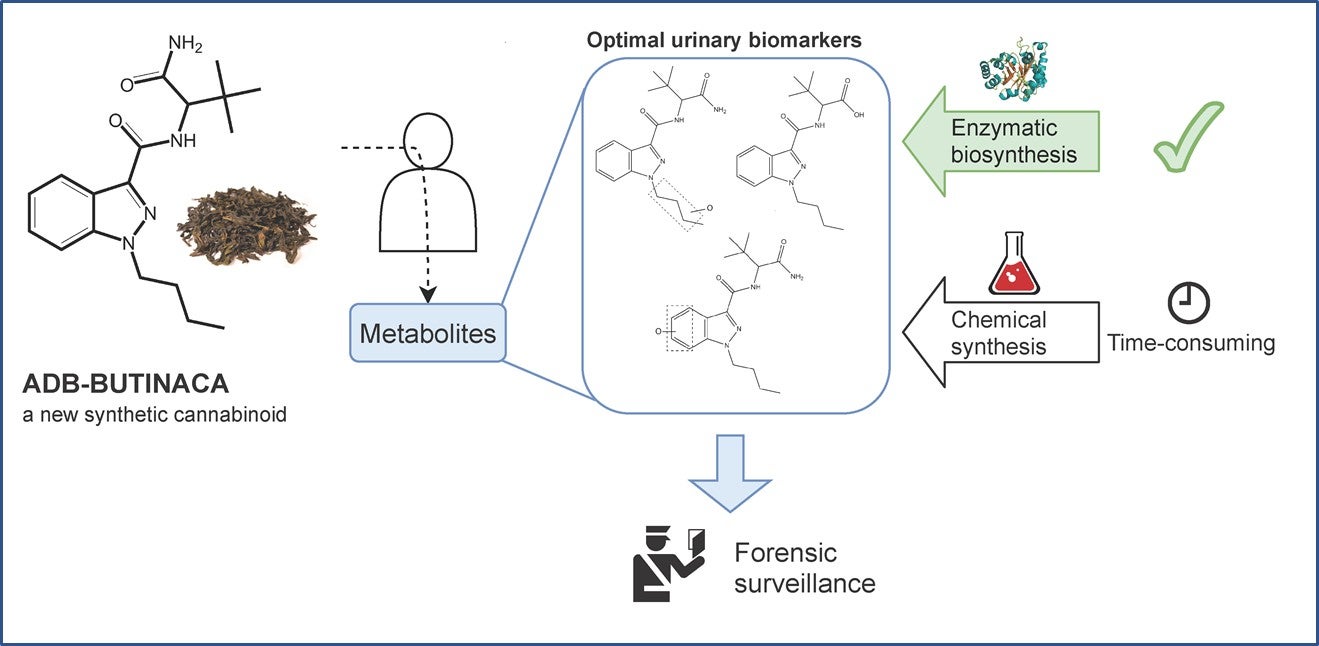Novel strategy for identifying biomarkers of synthetic cannabinoids
August 30, 2021NUS pharmaceutical scientists have developed a strategy to biosynthesize metabolites of a novel synthetic cannabinoid, ADB-BUTINACA, and identify its optimal urinary biomarkers for forensic surveillance.
Over the past two years, users of new psychoactive substances (NPS) accounted for the third largest proportion of drug abusers in Singapore. Synthetic cannabinoids, a sub-class of NPS, dominated the local NPS market for the past four years. The molecular structures of synthetic cannabinoids are being constantly modified by illicit manufacturers to circumvent legislative bans. With the recurring emergence of novel synthetic cannabinoids, forensic laboratories need to explore their metabolites as urinary biomarkers for forensic management.
ADB-BUTINACA is a new synthetic cannabinoid that was first identified in Europe in 2019. It entered Singapore’s local drug scene last year. It has been listed in various legislative acts of controlled substances worldwide. There are three metabolites of ADB-BUTINACA available as reference standards for routine forensic monitoring. However, these metabolites have been found to be absent or detected at low concentrations in urine samples of ADB-BUTINACA abusers. This provides the impetus to elucidate its metabolism in the human body and identify other potential metabolites for use as urinary biomarkers.
Instead of chemical synthesis of the metabolites as reference standards, a team led by Prof Eric CHAN from the Department of Pharmacy, National University of Singapore, applied concepts of drug pharmacokinetics and metabolism (DMPK) and biosynthesized unique metabolites of ADB-BUTINACA (see Figure) using human liver enzymes for characterisation. The DMPK method examines the breakdown of the drug compound in the human body based on its absorption, distribution, metabolism and excretion. Anonymous urine specimens taken from drug abusers were further analysed to curate and confirm the early putative biomarkers of ADB-BUTINACA. This work was performed in collaboration with the Analytical Toxicology Laboratory, Health Sciences Authority, Singapore.
The research team established a total of 15 metabolites of ADB-BUTINACA and their respective biotransformation pathways for the first time. Based on their research findings, they proposed three newly identified metabolites along with an existing reference standard as urinary biomarkers for diagnosing the consumption of ADB-BUTINACA. This can be used by forensic laboratories for surveillance purposes.
Prof Chan said, “Our unique methodology is expected to benefit the forensic fraternity who is constantly battling the emergence of novel synthetic cannabinoids. This will bring us closer to the goal of a drug-free world.”
The team plans to extend the current biosynthesis strategy to understand the renal excretion of the metabolites, which is an important yet neglected process that affects the occurrence and quantity of the metabolites of synthetic cannabinoids in urine samples.

Figure shows an illustration of the study design and the chemical structures of ADB-BUTINACA and its metabolites which have been identified as optimal urinary biomarkers for potential use in forensic surveillance.
Reference
Sia CH; Wang Z; Goh EML; Tan YL; Fong CY; Moy HY; Chan ECY*, “Urinary Metabolite Biomarkers for the Detection of ADB-BUTINACA Abuse” CLINICAL CHEMISTRY DOI: 10.1093/clinchem/hvab134 Published: 2021.


